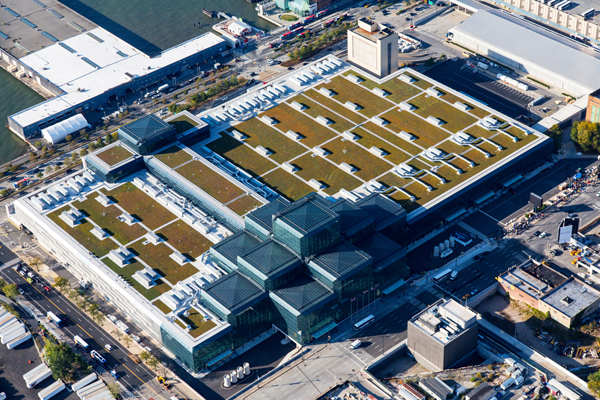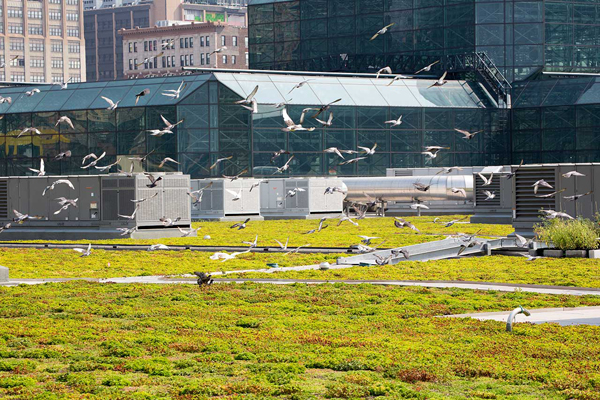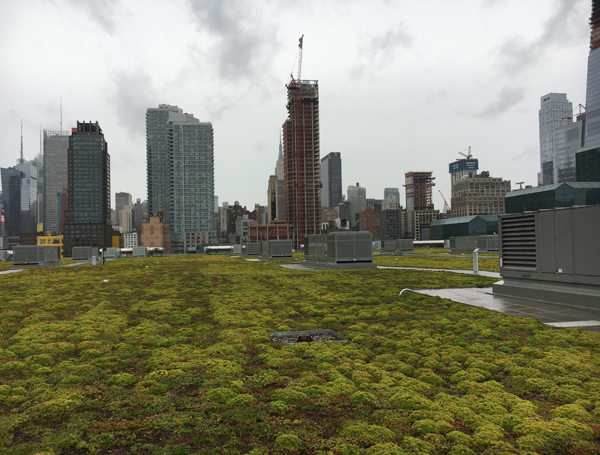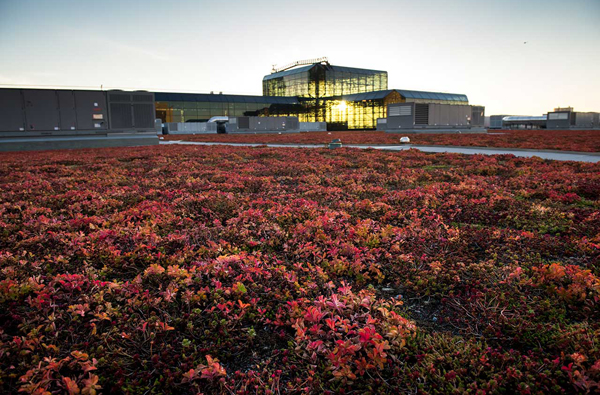
BY RANIA RICHARDSON | Despite a heavy drizzle, nearly two dozen intrepid folks were eager to tour the largest green roof in New York City. Armed with umbrellas and cameras, the group made its way through many backstage storage and construction areas and up a long metal staircase to the top of the Jacob K. Javits Convention Center. A spectacular panoramic view of Hudson Yards under construction rose above an expanse of succulent green stonecrop.
The mammoth Javits Center is located on 11th Ave. between W. 34th and 40th Sts. Trade shows and special events such as the Toy Fair, Auto and Boat Shows, and Small Business Expo support the city’s hotels, restaurants, and tourism industry, generating $1.9 billion in economic activity last year alone.
We were not here for business though, but for study and enlightenment. A group of pre-teen robotics students, a nascent green roof entrepreneur, and a mom with her two-month-old in a sling were all rapt, as Tony Sclafani, a representative for the behemoth center, told the story of how the Javits went from a “bird killer” to a “bird breeder.”
A number of years ago, New York City Audubon (an affiliated chapter of the National Audubon Society) identified the Javits Center as one of the biggest culprits for bird mortality in the city, due to its highly reflective glass and its proximity to the Hudson River, a directional for migrating flocks.
Between 2009 and 2014, the Javits underwent a half-billion renovation (partially funded by a $1.50-per-night hotel tax) that included expansion of the facility with a new exhibition hall and environmental improvements. To reverse their reputation with wildlife, they replaced the opaque glass with bird-friendly translucent windows printed with a dot matrix pattern to break up the reflection.

In addition, they installed the 6.75-acre green roof, trumped in size in the US only by the roof crowning a Ford Motor factory near Detroit. Overseen by architects FXFOWLE and Epstein Global, the upgrade has reduced energy consumption at the Javits by 26 percent and has earned it Leadership in Energy and Environmental Design (LEED) Silver status.
In an unexpected turn of events, the green rooftop has become an avian refuge. As the renovation was being completed, New York City Audubon began conducting ecological studies. They have since observed 26 bird species on or near the roof, including goldfinches, warblers, and falcons. No longer a place for fatal collisions, birds now build nests and lay eggs, forage for food, and experience some downtime during their journey south.
“We’re now in the season for migration,” said Susan Elbin, head of conservation at NYC Audubon, by telephone. “New York City is the hub for the ‘Atlantic Flyway.’ Fortunately, the new glass on the Javits has reduced its bird casualties by 90 percent.”
The bird-friendly glass was used to clad the building, and also for one wall of the green roof. In an in-person study, Elbin observed a white-throated sparrow — one of the biggest collision victims — hop right up to the wall and turn around, a sign that the glass was functioning as it should.
The living roof has become a habitat not just for birds, but also for insects and the bats that eat them, all under observation by Audubon. Also, hives and flower planters are in place to sustain 300,000 honeybees, at work creating a supply of the sweetener for future green roof visitors.
Right now the Javits roof is limited to the weight of one-inch soil planted with sedum, the perennial groundcover also known as stonecrop. (Not every rooftop is appropriate to grow produce, like the Brooklyn Grange, a farm atop a former warehouse in the Brooklyn Navy Yard.) Unlike the previous asphalt, the carpet of plants insulates the building, a major energy-saver from the renovation.
The tour group steps carefully on the loose concrete pavers that create a walkway between patches of green. Large herring gulls take off and land in the near distance. Ground nests are visible, but the breeding season is over and the chicks have grown into speckled juveniles. We see stripped chicken bones trapped in the vegetation. The city gull colony here does well in an urban environment — they are keen enough to pull leftover chicken wings out of the garbage and dine on the roof, leaving evidence behind.

We’re invited to come back to the green roof on a sunnier day, when the towers on the West Side sparkle, monarchs flit about, and grasshoppers dodge the young kestrels hunting for food. On a wet day like this, though, we are glad to learn that the sedum collects and filters storm water runoff, reducing the amount of water flowing into the sewers and thus improving the quality of the Hudson River.
Birds, bats, bugs and bees add value to the upgraded Javits Center by supporting biodiversity. When the sun goes down on the green oasis, a chorus of crickets may even drown out the noise of the city.
__________________________________________________________________
For more information, call 212-216-2000. To register for a free green roof tour, visit javitscenter.com/attend/green-roof-tours — where you can also access their live roof cam. Also visit NYC Audubon at nycaudubon.org.




































